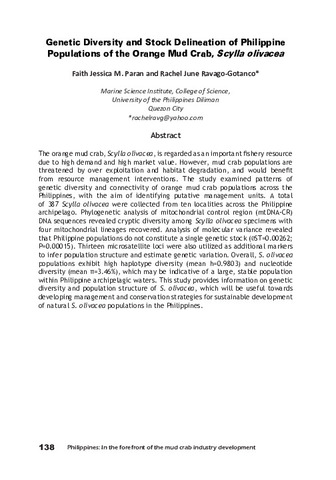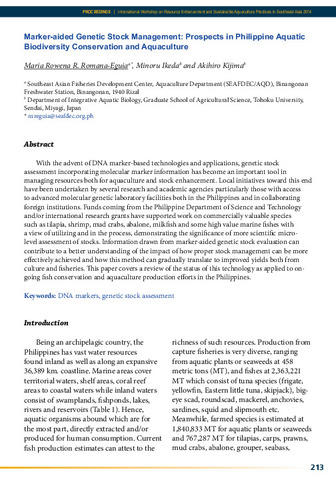Perlihatkan publikasi sederhana
Genetic diversity and stock delineation of Philippine populations of the orange mud crab, Scylla olivacea
| dc.contributor.author | Paran, Faith Jessica M. | |
| dc.contributor.author | Ravago-Gotanco, Rachel June | |
| dc.contributor.editor | Quinitio, Emilia T. | |
| dc.contributor.editor | Parado-Estepa, Fe Dolores | |
| dc.contributor.editor | Coloso, Relicardo M. | |
| dc.date.accessioned | 2017-08-25T08:54:51Z | |
| dc.date.accessioned | 2017-08-25T16:28:46Z | |
| dc.date.available | 2017-08-25T08:54:51Z | |
| dc.date.available | 2017-08-25T16:28:46Z | |
| dc.date.issued | 2017 | |
| dc.identifier.citation | Paran, F. J. M., & Ravago-Gotanco, R. J. (2017). Genetic diversity and stock delineation of Philippine populations of the orange mud crab, Scylla olivacea. In E. T. Quinitio, F. D. Parado-Estepa, & R. M. Coloso (Eds.), Philippines : In the forefront of the mud crab industry development : proceedings of the 1st National Mud Crab Congress, 16-18 November 2015, Iloilo City, Philippines (p. 138). Tigbauan, Iloilo, Philippines: Aquaculture Department, Southeast Asian Fisheries Development Center. | en |
| dc.identifier.isbn | 9789719931072 | |
| dc.identifier.uri | http://hdl.handle.net/10862/3172 | |
| dc.description | Abstract only. | en |
| dc.description.abstract | The orange mud crab, Scylla olivacea, is regarded as an important fishery resource due to high demand and high market value. However, mud crab populations are threatened by over exploitation and habitat degradation, and would benefit from resource management interventions. The study examined patterns of genetic diversity and connectivity of orange mud crab populations across the Philippines, with the aim of identifying putative management units. A total of 387 Scylla olivacea were collected from ten localities across the Philippine archipelago. Phylogenetic analysis of mitochondrial control region (mtDNA-CR) DNA sequences revealed cryptic diversity among Scylla olivacea specimens with four mitochondrial lineages recovered. Analysis of molecular variance revealed that Philippine populations do not constitute a single genetic stock (0ST=0.00262; P=0.00015). Thirteen microsatellite loci were also utilized as additional markers to infer population structure and estimate genetic variation. Overall, S. olivacea populations exhibit high haplotype diversity (mean h=0.9803) and nucleotide diversity (mean ~p3.46%), which may be indicative of a large, stable population within Philippine archipelagic waters. This study provides information on genetic diversity and population structure of S. olivacea, which will be useful towards developing management and conservation strategies for sustainable development of natural S. olivacea populations in the Philippines. | en |
| dc.language.iso | en | en |
| dc.publisher | Aquaculture Department, Southeast Asian Fisheries Development Center | en |
| dc.subject | Scylla olivacea | en |
| dc.subject | Philippines | en |
| dc.title | Genetic diversity and stock delineation of Philippine populations of the orange mud crab, Scylla olivacea | en |
| dc.type | Conference paper | en |
| dc.citation.spage | 138 | |
| dc.citation.conferenceTitle | Philippines : In the forefront of the mud crab industry development : proceedings of the 1st National Mud Crab Congress, 16-18 November 2015, Iloilo City, Philippines | en |
| dc.subject.asfa | aquaculture economics | en |
| dc.subject.asfa | crab culture | en |
| dc.subject.asfa | dna barcoding | en |
| dc.subject.asfa | fishery resources | en |
| dc.subject.asfa | genetic variation | en |
| dc.subject.asfa | genetics | en |
| dc.subject.asfa | marine crustaceans | en |
| dc.subject.asfa | mitochondria | en |
| dc.subject.asfa | overexploitation | en |
| dc.subject.asfa | phylogenetics | en |
| dc.subject.asfa | population genetics | en |
| dc.subject.asfa | resource conservation | en |
| dc.subject.asfa | resource management | en |
| dc.subject.asfa | vulnerable species | en |
Files in this item
Publikasi ini ada di koleksi berikut
-
Philippines : In the forefront of the mud crab industry development [44]
Proceedings of the 1st National Mud Crab Congress






